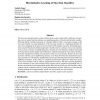Free Online Productivity Tools
i2Speak
i2Symbol
i2OCR
iTex2Img
iWeb2Print
iWeb2Shot
i2Type
iPdf2Split
iPdf2Merge
i2Bopomofo
i2Arabic
i2Style
i2Image
i2PDF
iLatex2Rtf
Sci2ools
JMLR
2008
2008
Discriminative Learning of Max-Sum Classifiers
The max-sum classifier predicts n-tuple of labels from n-tuple of observable variables by maximizing a sum of quality functions defined over neighbouring pairs of labels and observable variables. Predicting labels as MAP assignments of a Random Markov Field is a particular example of the max-sum classifier. Learning parameters of the max-sum classifier is a challenging problem because even computing the response of such classifier is NP-complete in general. Estimating parameters using the Maximum Likelihood approach is feasible only for a subclass of max-sum classifiers with an acyclic structure of neighbouring pairs. Recently, the discriminative methods represented by the perceptron and the Support Vector Machines, originally designed for binary linear classifiers, have been extended for learning some subclasses of the max-sum classifier. Besides the max-sum classifiers with the acyclic neighbouring structure, it has been shown that the discriminative learning is possible even with a...
| Added | 13 Dec 2010 |
| Updated | 13 Dec 2010 |
| Type | Journal |
| Year | 2008 |
| Where | JMLR |
| Authors | Vojtech Franc, Bogdan Savchynskyy |
Comments (0)

